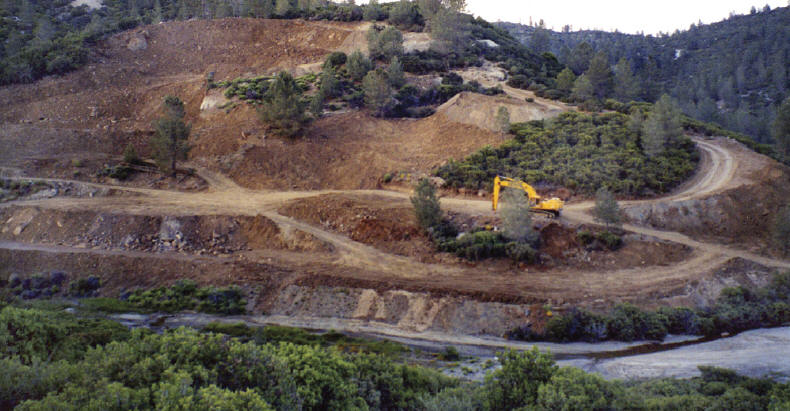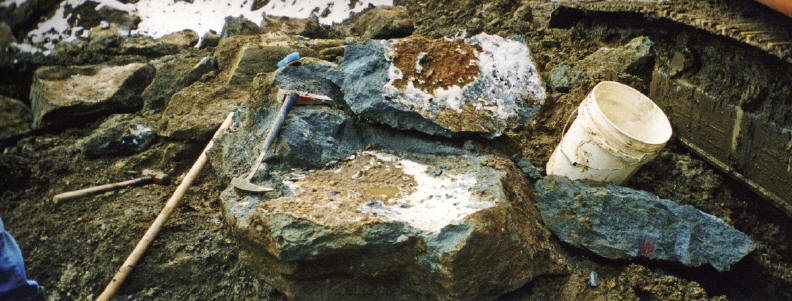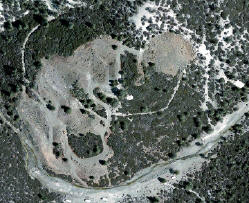Despite the effective mining techniquesused by The Collector’s Edge, aminor amount of productive material stillremains. The mud adhering to much ofthe material is tenacious and nearly impossibleto remove without repeated wettingand abrasion. This masking mudallowed considerable material to passthrough the washing system undetected and was eventually used in the reclamationwork. Hence, some of this mineralizedmaterial will continue to be foundthrough the action of rain and intensefield collector interest. The mine, however,will never again produce at a commercialscale.

Workings at the Benitoite Gem mine around 2000. M. Gray photo.
In 2008 John Veevaert of Weaverville,California (author) and Steve Perryof Davis, California negotiated purchaseof the entire nine-plus ton of inventory ofbenitoite specimens, partially processed,and unprocessed run-of-mine materialfrom The Collector’s Edge. Rough, unfinishedmaterial has been made available for purchase by collectors to try theirhand at cleaning their own specimens.

Extended workings at the mine around 2004. Collector’s Edge photo.

Unique photo showing benitoite-rich natrolitevein in situ. Collector’s Edge photo.
Perry and Veevaert are also processingmaterial for specimens and gemrough.

Big boulders with natrolite and benitoite veins. M. Gray photo.
THE GEOLOGY OF THE AREA
The Benitoite Gem mine is locatedin the New Idria mining district situatedin the southern end of the Diablo Range.
The district has been prospected sincethe early 1850's for gold, mercury,chromium, asbestos and mineral specimens.
The district covers a large body of serpentinite which was tectonicallyemplaced into surrounding sedimentaryand metamorphic rocks in the Jurassicperiod. A subsequent plate collisionput downward pressure on the serpentinite.
However, being of a lighter density,portions separated and migratedupward through the overlying layersof rock. This established the foundationfor a setting where these portions ofserpentinite would experience the lowtemperature and high pressure metamorphismknown as blue schist facies.
During the mid Miocene the regionwas intruded by small igneous bodies, primarily of syenitic composition. Thisproduced numerous calc-silicate veinsystems throughout the district. It wasone of these systems, altering the blueschist rock, that deposited the mineralizationfound at the Benitoite Gemmine.

Mine workings in October 2003. J. Bean photo.
ORIGIN AND STYLEOF MINERALIZATION
The elements that comprise benitoiteare thought to have been mobilizedfrom the host rock and deposited duringthe late stage cooling of hydrothermalfluids in calc-silicate veins fracturingthe wall rock of blue schist blocks. Othernearby benitoite deposits have a similarsetting bearing out the hypothesis.
Previous geologic investigations havesuggested that the benitoite mineralizationwas subsequent to the formationof the blueschist. Their analyses placethe age of the blueschist at between 100and 160 million years of age and the benitoitepresent in the cross cutting calc silicate veins at approximately 12 millionyears. All benitoite in situ at the BenitoiteGem mine is confined to blueschistblocks altered by hydrothermal veins.

Recent satellite image of the mine area after reclamation. Image bing.com.
The last phase of mineralization consistedof a pulse of natrolite that depositedwithin the vein system. Thevein-filling natrolite is found to encasemost, but not all, of the minerals depositedin the earlier phases. The upperzone of the Benitoite Gem mine has alarge concentration of albite veins and isdevoid of natrolite. It is in this upperzone that rich, deep blue and lustrouscrystals of benitoite were found commingledwith milky white albite.








 YueGongAnBei 44051102000467
YueGongAnBei 44051102000467


 |
|